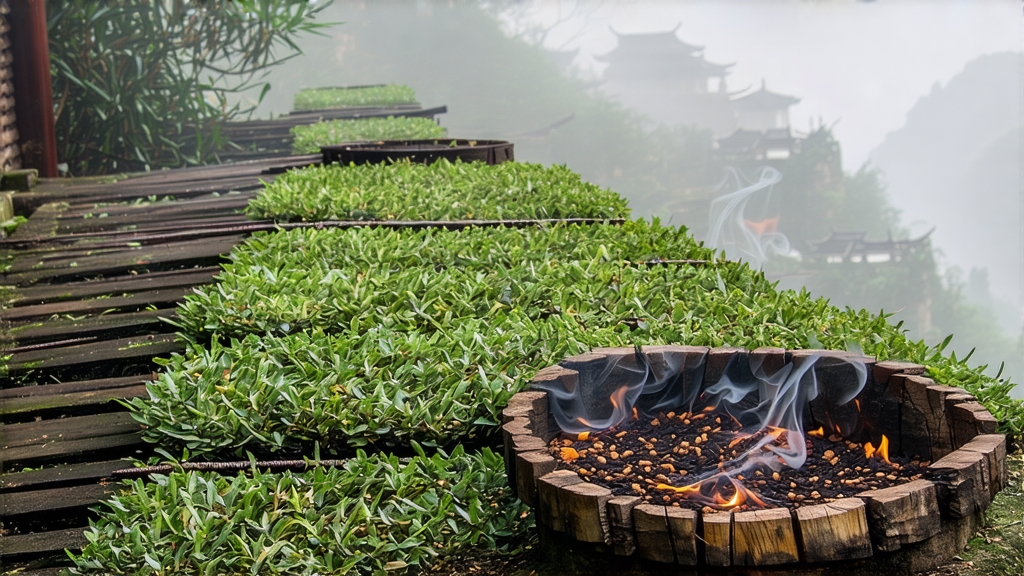
If you ask Chinese tea historians to name the first black tea ever created, they will point north-westward to the rugged Wuyi Mountains of Fujian Province and utter two syllables that have echoed since the late Ming dynasty: Zheng Shan Xiao Zhong—known in the West as Lapsang Souchong. Revered as the progenitor of every black tea on earth, this leaf carries within its twisted, tar-black ribbons the dual perfume of camphor-smoked pine and longan fruit, a fragrance so distinctive that it once perfumed the drawing rooms of Victorian London and inspired the birth of the English Breakfast blend. Yet behind the drama of its campfire nose lies a quieter story of refugee monks, Qing-era tax codes, and a 400-year-old craft that still depends on the same three pine species and one narrow canyon where the mist never lifts before noon.
History: From Ming War Refugees to London Parlors
The accepted chronicle begins around 1568, when retreating Ming soldiers passed through the village of Tongmu in the Wuyi core reserve. Local tea farmers, eager to dry their freshly picked leaves quickly for the fleeing troops, spread them over pine fires. The accidental smoke infusion yielded a cup so alluring that Dutch traders carried it to Europe in 1604, where it fetched prices higher than silver. By the early Qing, the Kangxi Emperor had designated the original canyon—Zheng Shan, “Original Mountain”—as a protected appellation, forbidding any tea made outside its 600-meter contour from bearing the name. Thus Lapsang Souchong became China’s first geographically indicated tea, two centuries before the French thought of “terroir.”
Micro-Terroir: Why Only 60 Hectares Matter
Tongmu lies inside a national park whose basalt cliffs force humid air to rise and condense into a perpetual mist. Daytime temperatures hover at 18 °C; at night they drop to 10 °C, slowing leaf respiration and concentrating amino acids. The soil is a gritty, mineral-rich laterite strewn with weathered volcanic tuff that drains instantly yet holds just enough moisture for the indigenous small-leaf cultivar—cultivar Xiaozhong—to send its roots two meters downward in search of fluorite veins. Within this microclimate grow the three resinous pines—Masson, Huangshan and Armand—that provide the smoking fuel. Move the same bushes one ridge west and the chemistry collapses; the tea becomes pleasant but no longer transcendent.
Leaf Grades: Souchong, Pekoe, and the Myth of “Smoky” versus “Unsmoked”
Western vendors often sell two styles: “traditional” pine-smoked and “unsmoked” Lapsang. Purists counter that the unsmoked version is simply Xiaozhong black tea from the Zheng Shan radius, not true Lapsang. Within Tongmu, farmers recognize four ascending grades:
- Xiaozhong (smallest, sweetest, barely smoked)
- Souchong (the classic export grade, three-hour smoke)
- Pekoe Souchong (adds one bud, lighter smoke, cocoa notes)
- Golden Crab (one bud, two leaves, zero smoke, honeyed malt)
Only grades 2 and 3 leave the village with the tell-tale pinewood bouquet; the top grades are kept for domestic connoisseurs who prize the natural longan sweetness over campfire theatrics.
Craft: The Eight-Step Dance of Fire and Mist
Plucking begins at dawn on the first clear day after the Grain Rain festival. Two leaves and a bud are snapped sideways to keep the epidermis intact, then cradled in bamboo baskets so shallow that no leaf is bruised under its own weight. Withering happens in Qing-era lofted barns whose latticed walls funnel mountain breeze across the leaves for eight hours, dropping moisture to 60 %. Rolling follows, but unlike the vigorous kneading used for Assam or Ceylon, Tongmu artisans apply a feather-light twist that fractures cell walls just enough to release oxidative enzymes without shredding the leaf. Oxidation is conducted on massive fir trays lined with wet cotton; the humidity keeps temperature below 22 °C, stretching the phase to four hours and developing the signature amber liquor. Now comes the moment that divides Lapsang from every other black tea: smoking. A pit is dug into the earthen floor, lined with volcanic stones, and topped with a grill of fresh pine boughs still dripping resin. The fire is fed slowly so